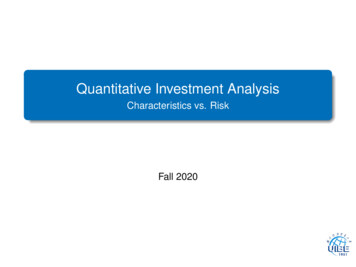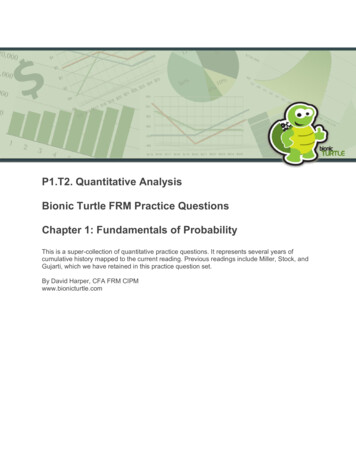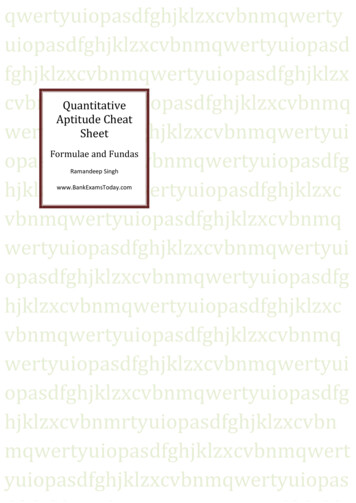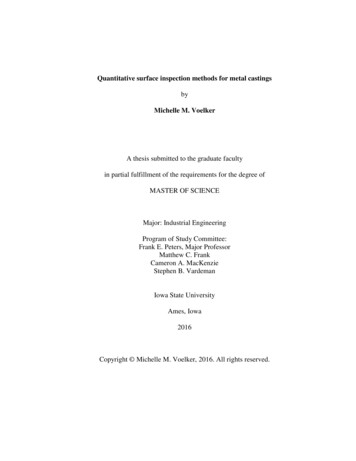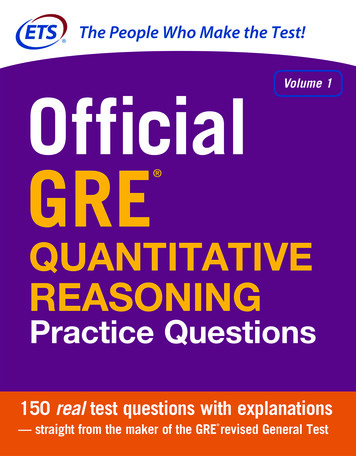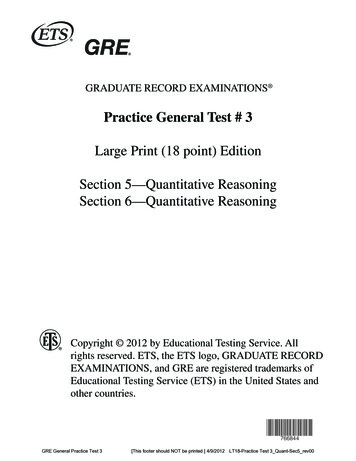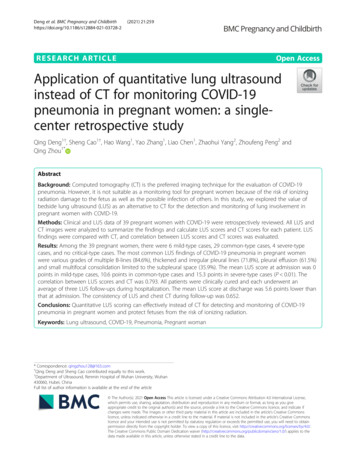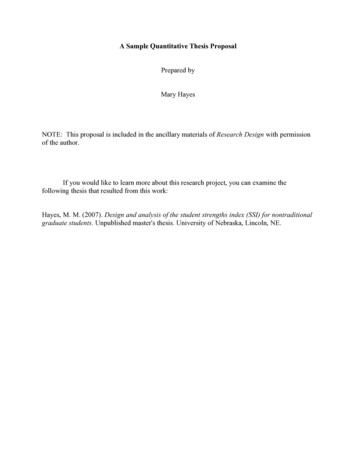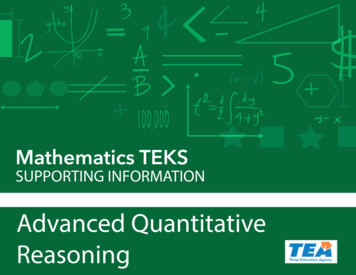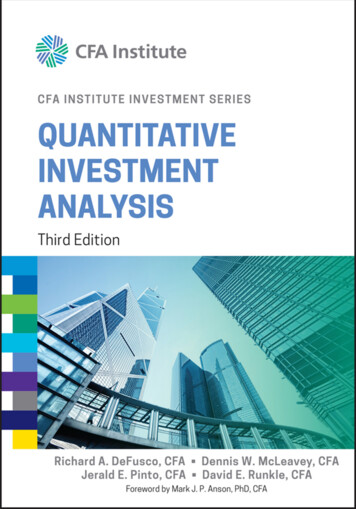
Transcription
QuantitativeInvestmentAnalysis
CFA Institute is the premier association for investment professionals around the world, withover 130,000 members in 151 countries and territories. Since 1963 the organization has developed and administered the renowned Chartered Financial Analyst Program. With a richhistory of leading the investment profession, CFA Institute has set the highest standards inethics, education, and professional excellence within the global investment community and isthe foremost authority on investment profession conduct and practice. Each book in the CFAInstitute Investment Series is geared toward industry practitioners along with graduate-levelfinance students and covers the most important topics in the industry. The authors of thesecutting-edge books are themselves industry professionals and academics and bring their wealthof knowledge and expertise to this series.
QuantitativeInvestmentAnalysisThird EditionRichard A. DeFusco, CFADennis W. McLeavey, CFAJerald E. Pinto, CFADavid E. Runkle, CFA
Cover image: r.nagy/ShutterstockCover design: WileyCopyright 2004, 2007, 2015 by CFA Institute. All rights reserved.Published by John Wiley & Sons, Inc., Hoboken, New Jersey.Published simultaneously in Canada.No part of this publication may be reproduced, stored in a retrieval system, or transmitted in any form or by anymeans, electronic, mechanical, photocopying, recording, scanning, or otherwise, except as permitted under Section107 or 108 of the 1976 United States Copyright Act, without either the prior written permission of the Publisher,or authorization through payment of the appropriate per-copy fee to the Copyright Clearance Center, Inc., 222Rosewood Drive, Danvers, MA 01923, (978) 750-8400, fax (978) 646-8600, or on the Web at www.copyright.com.Requests to the Publisher for permission should be addressed to the Permissions Department, John Wiley & Sons,Inc., 111 River Street, Hoboken, NJ 07030, (201) 748-6011, fax (201) 748-6008, or online at http://www.wiley.com/go/permissions.Limit of Liability/Disclaimer of Warranty: While the publisher and author have used their best efforts in preparingthis book, they make no representations or warranties with respect to the accuracy or completeness of the contentsof this book and specifically disclaim any implied warranties of merchantability or fitness for a particular purpose.No warranty may be created or extended by sales representatives or written sales materials. The advice and strategiescontained herein may not be suitable for your situation. You should consult with a professional where appropriate.Neither the publisher nor author shall be liable for any loss of profit or any other commercial damages, includingbut not limited to special, incidental, consequential, or other damages.For general information on our other products and services or for technical support, please contact our CustomerCare Department within the United States at (800) 762-2974, outside the United States at (317) 572-3993, or fax(317) 572-4002.Wiley publishes in a variety of print and electronic formats and by print-on-demand. Some material included withstandard print versions of this book may not be included in e-books or in print-on-demand. If this book refers tomedia such as a CD or DVD that is not included in the version you purchased, you may download this material athttp://booksupport.wiley.com. For more information about Wiley products, visit www.wiley.com.ISBN 978-1-119-10422-3 (Hardcover)ISBN 978-1-119-10459-9 (ePDF)ISBN 978-1-119-10460-5 (ePub)Printed in the United States of America.10 9 8 7 6 5 4 3 2 1
CONTENTSForeword xiiiPreface xvAcknowledgments xviiAbout the CFA Institute Investment Series xixChapter 1The Time Value of Money Learning Outcomes 1. Introduction 2. Interest Rates: Interpretation 3. The Future Value of a Single Cash Flow 3.1. The Frequency of Compounding 3.2. Continuous Compounding 3.3. Stated and Effective Rates 4. The Future Value of a Series of Cash Flows 4.1. Equal Cash Flows—Ordinary Annuity 4.2. Unequal Cash Flows 5. The Present Value of a Single Cash Flow 5.1. Finding the Present Value of a Single Cash Flow 5.2. The Frequency of Compounding 6. The Present Value of a Series of Cash Flows 6.1. The Present Value of a Series of Equal Cash Flows 6.2. The Present Value of an Infinite Series of EqualCash Flows—Perpetuity 6.3. Present Values Indexed at Times Other than t 0 6.4. The Present Value of a Series of Unequal Cash Flows 7. Solving for Rates, Number of Periods, or Size of Annuity Payments 7.1. Solving for Interest Rates and Growth Rates 7.2. Solving for the Number of Periods 7.3. Solving for the Size of Annuity Payments 7.4. Review of Present and Future Value Equivalence 7.5. The Cash Flow Additivity Principle 11124911121314151616181919242526272730313537v
viContents8. Summary Problems 3838Chapter 2Discounted Cash Flow Applications 43Learning Outcomes 1. Introduction 2. Net Present Value and Internal Rate of Return 2.1. Net Present Value and the Net Present Value Rule 2.2. The Internal Rate of Return and the Internal Rate of Return Rule 2.3. Problems with the IRR Rule 3. Portfolio Return Measurement 3.1. Money-Weighted Rate of Return 3.2. Time-Weighted Rate of Return 4. Money Market Yields 5. Summary References Problems 43434444464951525359646565Chapter 3Statistical Concepts and Market Returns Learning Outcomes 1. Introduction 2. Some Fundamental Concepts 2.1. The Nature of Statistics 2.2. Populations and Samples 2.3. Measurement Scales 3. Summarizing Data Using Frequency Distributions 4. The Graphic Presentation of Data 4.1. The Histogram 4.2. The Frequency Polygon and the Cumulative Frequency Distribution 5. Measures of Central Tendency 5.1. The Arithmetic Mean 5.2. The Median 5.3. The Mode 5.4. Other Concepts of Mean 6. Other Measures of Location: Quantiles 6.1. Quartiles, Quintiles, Deciles, and Percentiles 6.2. Quantiles in Investment Practice 7. Measures of Dispersion 7.1. The Range 7.2. The Mean Absolute Deviation 7.3. Population Variance and Population Standard Deviation 7.4. Sample Variance and Sample Standard Deviation 7.5. Semivariance, Semideviation, and Related Concepts 113116120
Contents 7.6. Chebyshev’s Inequality 7.7. Coefficient of Variation 7.8. The Sharpe Ratio 8. Symmetry and Skewness in Return Distributions 9. Kurtosis in Return Distributions 10. Using Geometric and Arithmetic Means 11. Summary References Problems vii121123125129134138140141142Chapter 4Probability Concepts Learning Outcomes Introduction Probability, Expected Value, and Variance Portfolio Expected Return and Variance of Return Topics in Probability 4.1. Bayes’ Formula 4.2. Principles of Counting 5. Summary References Problems 1.2.3.4.151151152152175184184188192194194Chapter 5Common Probability Distributions Learning Outcomes 1. Introduction to Common Probability Distributions 2. Discrete Random Variables 2.1. The Discrete Uniform Distribution 2.2. The Binomial Distribution 3. Continuous Random Variables 3.1. Continuous Uniform Distribution 3.2. The Normal Distribution 3.3. Applications of the Normal Distribution 3.4. The Lognormal Distribution 4. Monte Carlo Simulation 5. Summary References Problems er 6Sampling and Estimation Learning Outcomes 1. Introduction 2. Sampling 247247248248
viiiContents2.1. Simple Random Sampling 2.2. Stratified Random Sampling 2.3. Time-Series and Cross-Sectional Data 3. Distribution of the Sample Mean 3.1. The Central Limit Theorem 4. Point and Interval Estimates of the Population Mean 4.1. Point Estimators 4.2. Confidence Intervals for the Population Mean 4.3. Selection of Sample Size 5. More on Sampling 5.1. Data-Mining Bias 5.2. Sample Selection Bias 5.3. Look-Ahead Bias 5.4. Time-Period Bias 6. Summary References Problems 6Chapter 7Hypothesis Testing Learning Outcomes 1. Introduction 2. Hypothesis Testing 3. Hypothesis Tests Concerning the Mean 3.1. Tests Concerning a Single Mean 3.2. Tests Concerning Differences between Means 3.3. Tests Concerning Mean Differences 4. Hypothesis Tests Concerning Variance 4.1. Tests Concerning a Single Variance 4.2. Tests Concerning the Equality (Inequality) of Two Variances 5. Other Issues: Nonparametric Inference 5.1. Tests Concerning Correlation: The Spearman RankCorrelation Coefficient 5.2. Nonparametric Inference: Summary 6. Summary References Problems 0Chapter 8Correlation and Regression 327Learning Outcomes 1. Introduction 2. Correlation Analysis 2.1. Scatter Plots 2.2. Correlation Analysis 327328328328329
Contents 2.3. Calculating and Interpreting the Correlation Coefficient 2.4. Limitations of Correlation Analysis 2.5. Uses of Correlation Analysis 2.6. Testing the Significance of the Correlation Coefficient 3. Linear Regression 3.1. Linear Regression with One Independent Variable 3.2. Assumptions of the Linear Regression Model 3.3. The Standard Error of Estimate 3.4. The Coefficient of Determination 3.5. Hypothesis Testing 3.6. Analysis of Variance in a Regression with OneIndependent Variable 3.7. Prediction Intervals 3.8. Limitations of Regression Analysis 4. Summary Problems pter 9Multiple Regression and Issues in Regression Analysis Learning Outcomes 1. Introduction 2. Multiple Linear Regression 2.1. Assumptions of the Multiple Linear Regression Model 2.2. Predicting the Dependent Variable in a MultipleRegression Model 2.3. Testing whether All Population Regression CoefficientsEqual Zero 2.4. Adjusted R2 3. Using Dummy Variables in Regressions 4. Violations of Regression Assumptions 4.1. Heteroskedasticity 4.2. Serial Correlation 4.3. Multicollinearity 4.4. Heteroskedasticity, Serial Correlation, Multicollinearity:Summarizing the Issues 5. Model Specification and Errors in Specification 5.1. Principles of Model Specification 5.2. Misspecified Functional Form 5.3. Time-Series Misspecification (Independent VariablesCorrelated with Errors) 5.4. Other Types of Time-Series Misspecification 6. Models with Qualitative Dependent Variables 7. Summary References Problems 3431435435438440441
xContentsChapter 10Time-Series Analysis Learning Outcomes 1. Introduction to Time-Series Analysis 2. Challenges of Working with Time Series 3. Trend Models 3.1. Linear Trend Models 3.2. Log-Linear Trend Models 3.3. Trend Models and Testing for Correlated Errors 4. Autoregressive (AR) Time-Series Models 4.1. Covariance-Stationary Series 4.2. Detecting Serially Correlated Errors in an Autoregressive Model 4.3. Mean Reversion 4.4. Multiperiod Forecasts and the Chain Rule of Forecasting 4.5. Comparing Forecast Model Performance 4.6. Instability of Regression Coefficients 5. Random Walks and Unit Roots 5.1. Random Walks 5.2. The Unit Root Test of Nonstationarity 6. Moving-Average Time-Series Models 6.1. Smoothing Past Values with an n-Period Moving Average 6.2. Moving-Average Time-Series Models for Forecasting 7. Seasonality in Time-Series Models 8. Autoregressive Moving-Average Models 9. Autoregressive Conditional Heteroskedasticity Models 10. Regressions with More than One Time Series 11. Other Issues in Time Series 12. Suggested Steps in Time-Series Forecasting 13. Summary Problems 5489494494496499504504507512512514516Chapter 11Introduction to Multifactor Models Learning Outcomes Introduction Multifactor Models and Modern Portfolio Theory Arbitrage Pricing Theory Multifactor Models: Types 4.1. Factors and Types of Multifactor Models 4.2. The Structure of Macroeconomic Factor Models 4.3. The Structure of Fundamental Factor Models 5. Multifactor Models: Selected Applications 5.1. Factor Models in Return Attribution 5.2. Factor Models in Risk Attribution 1.2.3.4.525525525526527533533534537541542545
Contents 5.3.5.4.Factor Models in Portfolio Construction How Factor Considerations Can Be Useful in StrategicPortfolio Decisions 6. Summary References Problems xi549551552554554Appendices 557Glossary 567About the Editors and Authors 579About the CFA Program 581Index 583
Foreword“Central limits,” “probability distributions,” “hypothesis test”— investors have a bit of troublegenerating enthusiasm for such terms. Yet, they should be enthusiastic because every investorneeds these tools to analyze, compete, and succeed in today’s economic environment. Thefinancial markets and the participants in them become increasingly sophisticated every year.So, at times, it seems like you need a PhD in mathematics just to keep up with the markets.Fortunately, a PhD is not necessary to succeed. In fact, the financial market battlefield islittered with the credentials of highly educated individuals who have failed spectacularly despite their intense education. Nonetheless, the better equipped you are with the basic tools offinancial calculus, the better your chance of success.Quantitative Investment Analysis provides the necessary utensils for success. In this volume,you will find all the statistical gadgets you need to be a confident and knowledgeable investor.Math need not be a four letter word. It can make your wealth analysis sharper, your investmenttheme more precise, your portfolio construction more successful.Furthermore, this book is chock full of examples, practice problems (with answers!),charts, tables, and graphs that bring home in clear detail the concepts and tools of financialcalculus. Whether you are a novice investor or an experienced practitioner, this book has something for you. In fact, as I read the book in preparation for writing this foreword, I kept gettingunconsciously pulled into the examples; unwittingly, I became engaged in the book before Iknew it. But that effect is part of the beauty of this book: It is an easy-to-re
Quantitative inveStMent analySiS. CFA Institute is the premier association for investment professionals around the world, with over 130,000 members in 151 countries and territories. Since 1963 the organization has de-veloped and administered the renowned Chartered Financial analyst Program. With a rich history of leading the investment profession, CFa institute has set the highest standards .

